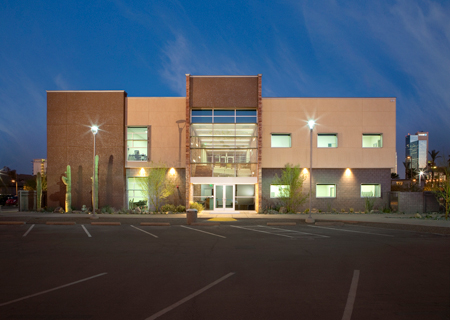Walk into the lobby of Rio Salado College’s new eco-friendly building in downtown Phoenix, Arizona, and one thing you notice right away is what is not there.
There is no glare from the brutal Sonoran desert sun – despite banks of windows stretching from the floor to the second story ceiling – thanks to tinted glass, light-filtering screens and articulating metal sun shades. The outside temperature is in the low-90s, but it’s not too cold inside (as it so often is here in the Valley of the Over-Air-Conditioned-Buildings). Take a deep breath: Not a whiff of the toxic odors common to many new buildings.
“The employees here feel like they won the lottery,” says Jeanne Lombardo. “When they moved in, there was no smell of chemicals from the paint or carpeting.”
Lombardo is the Assistant Director of Community Partnerships, Community Development, at Rio Salado Community College, and she clearly counts herself among the lottery winners. A former conversational English teacher who has lived and worked in Tokyo, Paris and London, a smile rarely leaves her face during the hour she shepherds a visitor through the 13,800 square-foot facility. Over six-hundred students use the building’s nine classrooms each day, Lombardo explains. Most of them are adults enrolled in English acquisition courses or preparing for their GED examination.
“What’s exciting,” Lombardo says as she leads the way into a classroom, triggering overhead ultra-efficient lights, “is that we’re already constructing sustainable themes into the instruction that’s taking place here. While learning English, students are mastering a new vocabulary organized around sustainability.”
Many native English speakers could also pick up a few new terms here, such as “graywater” (partially treated for drip-irrigation in the surrounding desert landscaping), “negawatt” (a unit of energy saved through conservation or greater efficiency), and “hydration station.”
The last is not, as cynics may think, a pretentious way of referring to a drinking fountain. A hydration station is a water dispenser, built into the wall and designed to encourage students to use refillable bottles – and, so, lessen that blight of the Southwestern landscape, disposable plastic water bottles. As Lombardo points out, the hydration stations are effective partly because they are quick and easy to use (a sensor detects when a bottle is present and starts the flow of cold water), and partly because students receive instant positive reinforcement in the form of a digital readout that displays the number of plastic bottles that will not end up in a landfill or on the side of the road, thanks to the user’s thoughtfulness.
In addition to motion detectors to control the lights, each room has a CO2 sensor. As people fill a given space, the building responds to higher levels of carbon dioxide by increasing the air flow into that room. Other sensors detect the changing amount of sunlight throughout the day and adjust overhead lighting automatically to conserve electricity.
As we head outside, Lombardo points to one of the building’s many aesthetic features: soaring stone walls in the two-story lobby. The warm-toned raw rock is an unusually hard form of sandstone. The stairs are made from the same material, but polished. The effect is a bit like walking through an old Native American structure like Casa Grande or Mesa Verde. In fact, the stone is from a quarry in neighboring Nevada. Earlier plans to use stone from the East coast were dropped to reduce the carbon footprint of construction. (Also, over ninety percent of waste materials generated by construction were recycled.)
The building sits on formerly contaminated ground, called a “brownfield,” which was once home to an auto dealership. The parking lot is surprisingly small, given the number of students who use the building, but that’s intentional.
“The downtown location is in part to eliminate the need for cars, and counter sprawl,” says Lombardo. “We’re located near light-rail and bus routes, and not far from neighborhoods where a lot of our students live.” A bike rack also sits by the entrance. Still, some students and instructors will need to drive here and the site is designed to minimize the environmental impacts from cars. There are four charging stations for plug-in electric vehicles and the parking lot is light-colored to reflect the intense sunlight and reduce pavement heating. The lot was built with pervious paving that soaks up the torrential summer monsoon rains, minimizing runoff and avoiding the need for new storm sewers.
The tour ends with a stroll around the extensive landscaping which features vegetation native to the Sonoran desert. There are palo verde trees for shade, stands of prickly pear, and, of course, the iconic plant of this region: the giant saguaro. The new center is a welcome addition to an area dominated by strip malls, boarded-up houses and empty lots filled with broken glass. It seems fitting that a building devoted to helping non-traditional students get an education and training for a successful future, may, by example, help Phoenix transform itself into a sustainable city.
The new building will have a grand opening celebration tomorrow, April 10, at 619 N. 7th Avenue, starting at 8 AM. The public is invited.
Design: Architectural Resource Team
Construction: D.L. Withers
For more information on Rio Salado College, click here.


